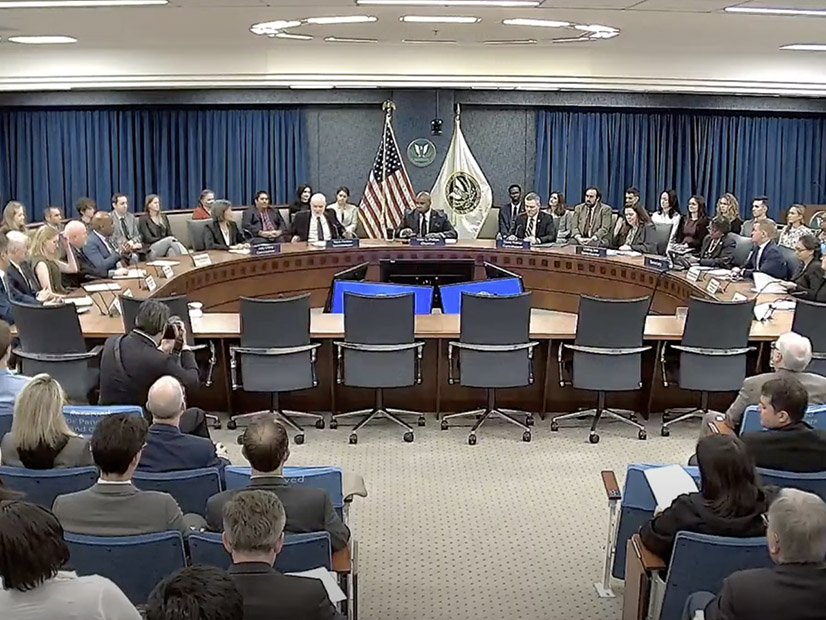WASHINGTON — FERC on Nov. 21 voted to approve Order 1920-A, which upholds most of the original’s changes to the commission’s rules on transmission planning and cost allocation while giving more consideration to states (RM21-17-001).
Commissioner Mark Christie (R), who voted against Order 1920 when it was issued in May, joined the Democratic majority in issuing the revised order, which addressed his main criticism of the original: Transmission providers now will be required to file any cost allocation proposals agreed to by states in a region alongside their own for the commission to consider.
The original order gave state entities six months to agree on a cost-allocation method for transmission projects, but planners could simply ignore it and file their own method. It represented a change from the Notice of Proposed Rulemaking that had drawn Christie’s support in the first place. (See FERC Issues Transmission Rule Without ROFR Changes, Christie’s Vote.)
FERC issues major orders like 1920 under Section 206 of the Federal Power Act, the same statute that covers complaints about utility rates and ISO/RTO rules. With Order 1920, FERC had to find that regional planning efforts around the country were leading to unjust and unreasonable rates and then come up with a just and reasonable replacement rate, Christie said at the open meeting.
“The changes made today in Order No. 1920-A to the replacement rate set by Order No. 1920 go a long way [toward] restoring the state role to what the NOPR promised, and I am pleased to support these changes,” he wrote in a partial concurrence. “I express my deep appreciation to my colleagues for their willingness to engage in good-faith negotiations leading to these important changes to the replacement rate.”
“This order builds upon an already strong Order No. 1920 and will further enhance the ability of state regulators to provide their important perspectives on the much-needed new transmission facilities our nation needs to ensure our grid can serve the significant growth in demand for electricity,” Chair Willie Phillips said.
Other changes Christie applauded include a requirement that if a transmission provider wants to change a cost-allocation agreement after it has gone into effect, they will have to consult with state regulators. It also will allow the State Agreement Approach in PJM, which New Jersey used to plan connections for state-backed offshore wind, to stay in place under the new regional planning regime.
Christie noted in his concurrence that “the requirement in Order No. 1920 that large corporate power-purchasing preferences must be a factor in planning long-term scenarios is explicitly removed. That was one of the most unconscionable, special-interest driven features of Order No. 1920, directing transmission providers to plan hundreds of billions of dollars of transmission projects to subsidize the power-purchasing preferences of huge multinational corporations and shifting the costs to residential and small-business consumers already struggling to pay their monthly power bills.”
That means expensive transmission lines to connect corporate demand with resources they have contracted with will not be cost allocated to all customers in a region, he added.
Commissioner David Rosner said he was proud to vote out a “bipartisan order” that makes meaningful changes to Order 1920 based on the rehearing requests but still fulfills the original’s purpose of identifying needed regional transmission infrastructure that makes the country more secure.
“The need for this rule is urgent and obvious,” Rosner said. “In conversations I have had around the country these last few months in my new role, I have come to see that there is broad agreement that we have a pressing need for more infrastructure.”
New large customers are looking to connect to the grid while the uses of electricity are expanding into new areas of demand, while the interconnection queues are overflowing with resources that Order 1920-A will help get connected to the grid, he added.
Commissioner Judy Chang said Order 1920-A should get the country building major transmission lines.
“Based on that experience, I think Order 1920 — and now Order 1920-A — is a very strong order, and substantially improves transmission planning and helps to solve the cost allocation problem that we’ve been talking about for the last 20 years,” Chang said.
Failing to agree on cost allocation leads to a logjam of transmission projects that the new rule should help to break up, she added.
Commissioner Lindsay See (R) said she recused herself from participating in the order on the advice of FERC’s designated ethics official, but she has “been really encouraged by what I’ve heard about the process that led to it. This order involves some of the hardest and most important issues before the commission, [and] I’ve heard from my colleagues that it reflects many hours of serious discussion trying to understand different points of view.
FERC had not published the text of the order by the close of business Nov. 21, so several stakeholders declined to comment until they had actually read it.
But Grid Strategies President Rob Gramlich, who has long supported the kind of changes in Order 1920, said he liked that FERC is moving forward with the new planning and cost allocation rules.
“The states that were concerned should be very happy,” Gramlich said. “It’s kind of a bipartisan, FERC-state kumbaya moment. No one got everything, everyone got something.”
Christie’s concurrence cuts the legal and political risk, he added.
“Hopefully most states lay down their arms and start participating in planning,” Gramlich said.



